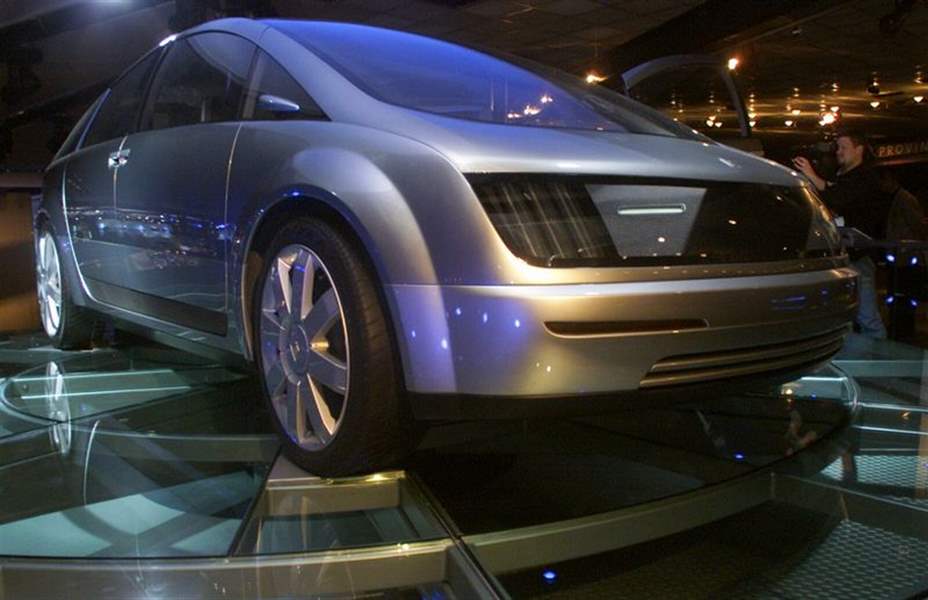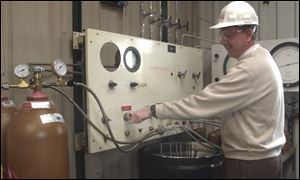
Affordable fuel-cell autos a decade down the road
2/9/2003
The Hy-Wire is a fuel-cell concept from GM, which is optimistic about the technology.

The Hy-Wire is a fuel-cell concept from GM, which is optimistic about the technology.
Don't plan on trading in your gas-guzzling, smoke-spewing pickup for an emission-free hydrogen-powered model anytime soon. Mass production of fuel-cell vehicles is at best 10 years off, and even then, such vehicles will at best make up 5 percent of cars sold.
A number of puzzles must be solved before hydrogen fuel-cell vehicles line up on the Central Avenue car dealer strip. Will they have tanks with compressed hydrogen or use another means to get the fuel? Will consumers get hydrogen at specially designed fuel stations? How will fuel-cell vehicles, which currently cost an average of $700,000 each, ever be affordable?
Still, with war looming in oil-rich Iraq and U.S. gasoline prices rising, the prospect of using hydrogen as fuel and lessening America's dependence on petroleum appeals to some consumers.
“It seems really like a better deal to me,” said Joe Bernal of Sylvania. “If we're going to pay $3 to $4 a gallon for gas, that's pretty scary.”
Previously an alien idea to many northwest Ohioans despite roughly a decade of development, automotive fuel cells grabbed attention when President Bush recently proposed spending $1.2 billion on research over five years.
Of that money, $720 million of that money would be geared toward hydrogen storage, delivery, and production. But all of the funds would need to be budgeted by Congress.
Help definitely is needed in those areas, industry experts said.
“You can't have a fuel cell that's viable for market until you have the technology to support it,” said Eron Shosteck, a spokesman for the Alliance of Automotive Manufacturers in Washington. “[Hydrogen] has to be compressed. It's not the same as using an underground tank at the gas station.”
Hydrogen for automotive fuel cells must be highly pressurized, and keeping enough of it bottled in a vehicle to travel around 300 miles or refining it onboard from a hydrocarbon such as gasoline are among avenues researchers are traveling. Current test vehicles have nowhere near the storage capacity to reach such mileage.
Experts agree widespread use of fuel cells will be found in items such as power generators, laptops, cell phones, and probably even buses before cars and light trucks because of their stationary or limited-distance uses.
Working essentially like batteries, fuel cells use a chemical reaction between hydrogen and oxygen to make electricity, leaving only water and heat as byproducts. Some fuel-cell vehicles, such as the Jeep Commander and Commander2 concepts introduced a few years ago, process hydrogen from gasoline or methanol.
There are some fuel-cell vehicles on U.S. roads being used as demonstrators. The Toyota FCHV and Honda FCX, for example, are at universities and governments in California. The Ford Focus FCV - a hybrid that also uses a battery pack and regenerative braking - is expected to be in low-volume production next year.
Although fuel-cell vehicles aren't routinely found on the Ohio Turnpike, a four-employee Sylvania company is planning for the day they will be.
AltFuel Solutions plans to build a Cleveland-area hydrogen station, which initially will be used to refuel natural-gas vehicles. Hydrogen will be extracted from the natural gas once fuel-cell vehicles become available, said Eric Christiansen, the company's program manager.
The company, which received a $45,000 state grant last year for planning, hopes to build outlets statewide and serve as a model to gas stations for making a gradual switch in fuels, Mr. Christiansen said. Eventually, the AltFuel station will make hydrogen from renewable energy sources instead of natural gas, he said.
“You can't make the change overnight,” he said. “It's demonstrating the different stages that are going to occur.”
How quickly the change will occur is unclear.
The government estimates mass production of fuel cells could begin in 2015 if the technology is ready and refueling systems are in place. Affordable fuel cell options, then, could be in dealership showrooms by 2020, it predicts.

Cliff Caldwell fills hydrogen cylinders at AGA Gas, Inc., in Maumee, which supplies the gas for fuel cell research.
Nearly every major automaker worldwide has some form of fuel-cell technology under way. General Motors Corp. is the most optimistic about having fuel-cell vehicles in mass production in 10 years, while some competitors put it at 20 years, said David Cole, director of the Center for Automotive Research at the Environmental Research Institute of Michigan in Ann Arbor.
Automakers won't invest in manufacturing facilities until methods for refueling vehicles are in place, Mr. Cole said. Meanwhile, GM is packaging fuel cells with other technology, such as electronic steering, to make them more attractive to customers despite added costs, he said.
The price of an automotive fuel cell compared with that for an internal-combustion engine has declined from 1,000 times more to 10 times more, and costs will continue to fall, Mr. Cole said.
Work is being done at a Perrysburg plant to lower the costs of a key fuel-cell part. Bulk Molding Compounds, Inc., which has 90 local employees, makes a graphite-filled vinyl ester compound, a type of plastic that doesn't melt, which customers mold into plates used in fuel cells.
Being able to mold or press the plates instead of machining them from graphite would remove a major roadblock for fuel cells, said John Turner, principal scientist for the National Renewable Energy Laboratory in Golden, Colo.
Another significant hurdle for automotive fuel cells is the need to shrink their size, said Levi Thompson, a chemical engineering professor at the University of Michigan in Ann Arbor.
A corporate-sponsored project at the university is looking at whether thousands of micro fuel cells can be used to power a vehicle instead of one large one, he said.
Hydrogen production itself is a problem for fuel cells because not enough is made to support large numbers of them.
The United States produces about 9 million tons of hydrogen a year, mostly from natural gas, or enough to power 20 million to 30 million vehicles, according to federal estimates. Power for half of the 200 million vehicles now on the road would require 40 million tons of hydrogen a year.
From an environmental standpoint, a system for making hydrogen from natural resources needs to be developed, Mr. Turner said. For example, he said, electricity could be made from wind and combined with water.
AGA Gas, Inc., which has a Maumee operation that transfers various bulk gases into cylinders, supplies hydrogen for fuel cell research. Major oil companies such as BP PLC, however, likely will move into producing and distributing hydrogen and cut current suppliers out, said Cliff Caldwell, Independence, Ohio-based manager of specialty gas for the firm Linde Gas Group.
Yet fuel cells hold a lot of promise for companies such as Toledo's Dana Corp., which makes engine parts and has research under way in three countries on more than 50 projects. Bulk Molding Compounds of West Chicago, Ill., is ready to expand its Perrysburg plant if fuel-cell technology takes off.
Efforts to make automotive fuel cells available to customers certainly need a boost from President Bush, said Bob Zurek, Bulk Molding vice president of manufacturing and a minority owner.
“It's just plodding long,” he said.
Both Michigan and Ohio are looking to attract nascent fuel-cell manufacturing to their states, which rely heavily on building traditional car engines and transmissions. Ohio last year launched a three-year fuel-cell initiative with $103 million in grants, low-interest loans, and other assistance, some of which is helping Sylvania's AltFuel with its fueling-station project.
“This is an economic threat for Ohio,” said Bruce Johnson, director of the Ohio Department of Development. “It's also an economic opportunity for us.”